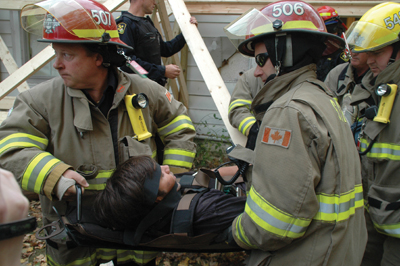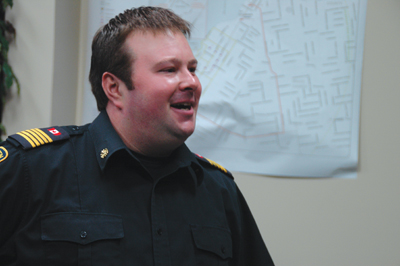
Features
Emergency & disaster management
Hot topics
Emergency preparedness
Saugeen Shores, Ont. – In 2009, the municipality of Saugeen Shores on Lake Huron was named a host municipality to the Bruce Power nuclear generating station.
November 22, 2012
By
Laura King
Saugeen Shores, Ont. – In 2009, the municipality of Saugeen Shores on Lake Huron was named a host municipality to the Bruce Power nuclear generating station.
 |
|
| Members of the Saugeen Shores Fire Department participate in rescue operations headed by the Ontario Provincial Police special teams during Huron Challenge-Trillium Resolve in October. Photo by Laura King
|
That designation carries massive responsibility for Chief Phil Eagleson and the 58 volunteer members of the Saugeen Shores Fire Department, primarily planning for a nuclear emergency. That responsibility became much more real after the Fukushima Daiichi nuclear disaster in Japan in March 2011.
“In the wake of Fukushima we knew we had to do more,” says Eagleson. “We had to provide the highest level of emergency planning and preparedness we could for the citizens of Saugeen Shores as well as for citizens surrounding the nuclear plant.”
The Fukushima disaster – equipment failures, nuclear meltdowns, and releases of radioactive materials after an earthquake and tsunami – was the largest nuclear disaster since Chernobyl in 1986.
The Bruce A and B nuclear generating plants near Kincardine, Ont., provide 30.1 per cent of the province’s power. Bruce Power regularly runs emergency drills but a mock disaster in mid-October that included 70 municipal, provincial and federal agencies, and 1,000 participants, was the largest to date.
The basis for the exercise at Bruce Power was a tornado similar in strength to the one that hit Goderich, Ont., in August 2011. The tornado resulted in a power loss at Bruce Power. Although the Bruce Power site was closed to reporters and spectators, the Saugeen Shores Fire Department partnered with the Ontario Provincial Police and other agencies to run a series of evolutions over five days that gave its members access to myriad specialties including high-angle and technical rescue and hazmat operations.
Eagleson, who was honoured in 2011 by the Ontario Association of Fire Chiefs with the VFIS Award for improving recruitment and retention in his department, says the exercise – called Huron Challenge-Trillium Resolve – gave firefighters access to specialized skills and operations taught by highly trained experts.
“When we were approached by Emergency Management Ontario and Bruce Power we said yes to the idea of the Huron Challenge,” Eagleson says.
“At the time, it definitely wasn’t an event; it was more a series of planning principles. And it has snowballed from there; we started with one event which led to three more which led to us sort of being the poster child for the whole exercise and we enjoyed it. We definitely got more out of it than any other municipality as most of the events were centred around Saugeen Shores. We met more players, interacted with more agencies and we really used it as a learning experience to network with other groups.”
Saugeen Shores is a mutual-aid partner for Bruce Power, but after Fukushima Bruce Power’s objective was to prove self-sufficiency. Bruce Power Fire Chief Brian Cumming says the facility’s new off-site emergency management centre – with its own AM radio frequency for communicating with area residents – its five new 3,000-U.S.-gallons-per-minute pumpers that were used to cool the reactors, and upgraded protocols between fire and security, all contributed to the ability to control the incident.
“The scope was a worst-case situation where there was no power and the infrastructure was damaged,” Cumming says.
“There were casualties not only at the nuclear plant but also at the site – there were injuries to people and damage to property. The whole pretence was to set up a command crew so that they would have to prioritize and deal with multiple tasks that the same time.”
The four Spartan trucks, built by Dependable in Brampton, Ont., pumped water for 24 hours to cool the reactors. There was no release of radioactive material.
“Really the intent was to demonstrate our capability to deploy emergency mitigating equipment,” Cumming says, “including portable pumps, which were our fire trucks, and to be able to sustain the operations. We ran the trucks for 24 hours to demonstrate that we had the ability to sustain operation. The trucks have 3,000-U.S.-imperial-gallons-per-minute pumps – triple what municipalities have for their apparatuses. From a technical standpoint, all the discharges are flow metered so we know exactly what the flow and pressure is.
“Really the concept is to take a piece of emergency equipment that people are very familiar with, and, in extreme conditions, instinctively know how to operate this equipment – taking standard firefighting equipment and knowing how to deploy it in a different scenario.”
Aside from Bruce Power, there were 36 venues across 10,000 square kilometres at which municipalities, fire departments, special teams and other provincial and federal response agencies participated in drills. In Saugeen Shores – which comprises Port Elgin, Southampton and Saugeen Township – the five-day exercise started on Monday, Oct. 15, with high winds and flooding.
 |
|
| Saugeen Shores Fire Chief Phil Eagleson’s department played a significant role in the mock disaster that affected the Bruce Power nuclear generating station and surrounding communities. Photo by Laura King
|
“Monday morning we experienced torrential rain and heavy wind in Saugeen Shores, which led to flooding and the damage of one building,” Eagleson says. “Monday afternoon, there was more extreme wind and a building was damaged. We responded quickly to the scene, and called for assistance from OPP UCRT team, because the building had collapsed and we could not reach the trapped victims.”
The scenario called for five people to be trapped in the building, a two-storey home on a suburban street in Saugeen Shores. The OPP’s Urban CBRNE Response Team (UCRT)) shored up the structure and worked with Saugeen Shores firefighters to stabilize the house then free patients from the basement using technical-rescue and high-angle rescue techniques, and from the attic using the aerial ladder.
While at the damaged home, responders discovered a clandestine lab on the grounds; OPP bomb technicians and hazmat technicians were called in to diffuse and decontaminate the scene.
“Firefighters were on standby for the duration of the exercise,” Eagleson says. “For four to five days, fire crews with fire pumpers looked after decontamination of victims and rescuers and provided standby support to rescue ops.
“The UCRT team was extremely welcoming and inviting to the volunteer firefighters in all of their operations – they never once completed an evolution without putting their arm around two or three firefighters and saying this is what we’re doing and how and why, and teaching them some tricks. In the dozens of evolutions they did at the house – inside, on the roof – they always involved the firefighters to show them why, where, how. It gave us as fire people a better appreciation for the UCRT team’s capabilities and how they perform their jobs.”
Through the entire exercise, the incident management system (IMS) was in place and the fire captain on scene was the incident commander.
“There was never any friction between the OPP and fire,” Eagleson says. “The OPP led the rescue operations but the overall command of the scene remained with fire.
Bruce Power’s Frank Saunders, the vice-president of nuclear oversight and regulatory affairs, says IMS was chosen because of its prevalence in North America.
“If you look at Fukushima or some of the big disasters in the Unites States, the first thing you realize is that an accident doesn’t happen in isolation; if you’ve got a big natural event, if it affects your nuclear plant it’s going to affect other things too, so we were looking for a system that’s going to work for everyone.
“The incident management system is the method of choice in the U.S. and in Ontario, so when you looked at it, that’s what it’s designed for; that was really the decision – something that could handle a broad set of situations. We also wanted something that would match with the province and municipalities and wasn’t something that they had to learn.”
More than 30 of Saugeen Shores’ volunteer firefighters were involved in Huron Challenge-Trillium Resolve; some were unavailable during daytime work hours but all members participated in some aspects of the exercise, from superior tanker-shuttle training to tours of the OPP base camp.
During the exercise, just as the Saugeen Shores Fire Department responded to the damaged home, the tornado hit Bruce Power and knocked out power to the municipality, which opened its emergency operations centre (EOC).
“And,” says Eagleson, “we were informed that there may be a risk to the nuclear plant – we weren’t given any more details then. We experienced more flooding and severe weather-related incidents in Saugeen Shores, at which point Public Safety Canada contacted us and asked for an area where they could set up their remote monitoring equipment. They arrived quickly with a helicopter and started to set up for radiation detection in the environment.”
Saugeen Memorial Hospital activated its emergency plan and set up a decontamination unit but was overwhelmed with casualties from the storm and requested help from the provincial Emergency Medical Assistance Team, or EMAT. Later, the Saugeen Shores Fire Department was informed through the provincial emergency operations centre that Bruce Power had requested it set up an emergency worker centre, or EWC, at the Southampton fire hall to decontaminate workers leaving the Bruce Power site and register workers who would be required to report to Bruce Power.
Finally, the fire department was asked to set up a reception evacuation centre, or REC; the Saugeen Shores emergency control group contacted the Canadian Red Cross, which set up the REC at the local sports complex. St. John Ambulance helped the Red Cross with meals for evacuees and assessed patients.
In the sportsplex parking lot, the Federal Radiological Assessment Team (FRAT) and Ontario’s assurance monitoring group monitored people for radiation contamination.
In neighbouring communities, fire departments were involved in mock emergencies that ranged from a tanker-truck rollover to severe-weather responses.
“Exercises are an important part of any preparedness tool,” says Eagleson. “They very much need to be part of a fire department’s training program because they actually let you test your capabilities, but more importantly, they let you network with those other agencies that you have to work with in a big events. Here’s our small fire department and we’re doing a reception evacuation centre, decontamination, technical rescue, public security . . . . You never want to exchange business cards for the first time during an emergency. It’s much better to know beforehand those organizations you’re working with and what their capabilities are.”
While lessons learned from the exercise are still being compiled, Saunders says nuclear oversight and regulatory affairs, says the biggest pluses from Huron Challenge-Trillium Resolve were the co-ordination of agencies and the institution of the AM radio component to keep residents informed.
“What we’ve really done is now look at emergency response as a co-ordinated effort so it’s not just fire, EMS or security. Especially when you have a very big event, to think in a co-ordinated way about your resources and what you can do with them, it’s important to be able to make best use of all that and make sure you can talk even if your phones don’t work and the power is off.”
Bruce Power will share its lessons learned with other North American nuclear sites in the next couple of months. A cost estimate on the exercise was not available.
Print this page